 This is another article dedicated to the outfits pictured in “Gentleman Jack” series. This time, we’d like to look at the clothing pieces of female characters, including Ann Walker, Marian Lister, Eliza Preistly, Vere Hobart, and Queen Marie of Denmark. In comparison to the Anne Lister’s stage costumes, these outfits are so much more feminine, delicate, and fitting the 1830s fashion. Some of these clothing articles are even authentic vintage pieces, but most of them, of course, are made by the wardrobe team of the show. So, let’s delve into fashionable mid-19th-century clothing styles.
This is another article dedicated to the outfits pictured in “Gentleman Jack” series. This time, we’d like to look at the clothing pieces of female characters, including Ann Walker, Marian Lister, Eliza Preistly, Vere Hobart, and Queen Marie of Denmark. In comparison to the Anne Lister’s stage costumes, these outfits are so much more feminine, delicate, and fitting the 1830s fashion. Some of these clothing articles are even authentic vintage pieces, but most of them, of course, are made by the wardrobe team of the show. So, let’s delve into fashionable mid-19th-century clothing styles.
This article is based on the video from a YouTube channel “Costume CO”.
Read also: Stage costumes of Gentleman Jack series, a scandalous 2019 historical drama
Gentleman Jack stage costumes. Extravagant and historically accurate outfits of Anne Lister
In this material, we take a closer look at the costumes of Anne Lister’s love interest Ann Walker, along with some of the other supporting characters.
Ann Walker
Ann Walker’s carriage dress is made from blue floral silk with a matching pelerine. A pelerine is a cape made of lace or in this case from a matching dress fabric.
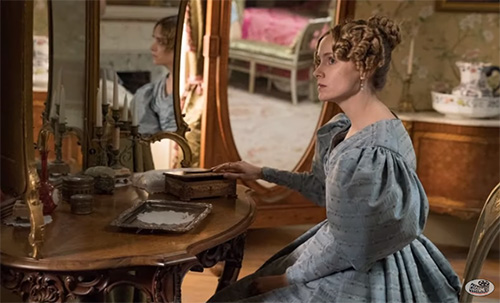
The costume and set designer of this series Tom Pye says, “In contrast to Anne Lister's more masculine looks, I ended up choosing particularly feminine and frothy looks for the women around her, fully embracing the more eccentric fashions of the 1830s with the huge gigot sleeves, bell-shaped skirts, large bonnets, and hats”.
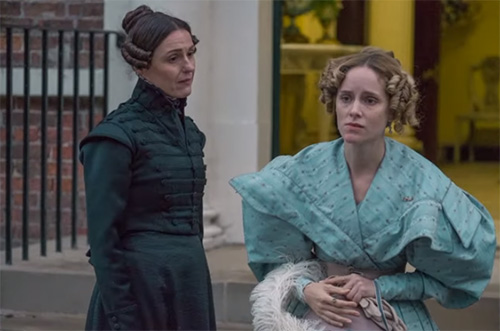
The pelerines would often be tucked into the belt, like we see here.
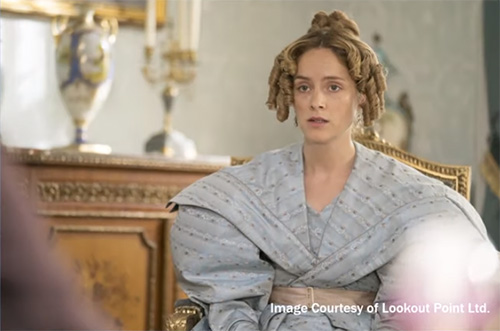
The actor Sophie Rundle who played Ann Walker in “Gentleman Jack” says, “The dresses are amazing, the fabrics are beautiful, and a lot of these were made for me, so they're real pieces of storytelling and they have a real impact on who you are”.
These two French fashion plates – the one on the left is from 1832 and the one on the right is from 1833 – illustrate the exaggerated silhouette of the fitted bodice and bell-skirt and gigot sleeves. The blue dress on the right has an oversized pelerine, just like Ann’s.
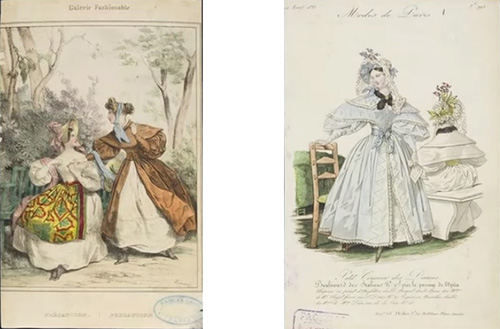
Tom Pye said in an interview with Radio Times that he made actor Sophie Rundle wear three petticoats at once. He added, “To really get that fabulous shape, you need a lot of fabric underneath to hold it out. It's all in proportion – if the skirt’s not big, it doesn't make sense of the huge sleeves and the hat”.
And then, to change up the look that we see here, Ann is wearing a whitework embroidered pelerine or fichu.
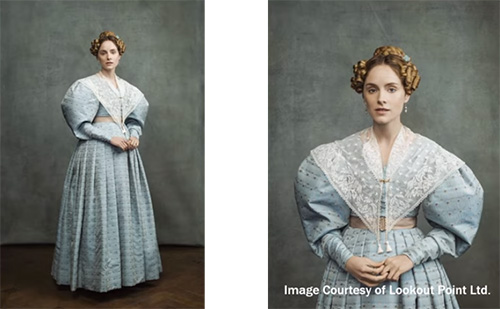
Here are two examples of pelerine fichus from The Centraal Museum in the Netherlands. The collar on the left dates between 1825-1875, it's made from embroidered cambric or batiste, a lightweight closely-woven white linen or cotton fabric. And the embroidered tulle collar on the right dates between 1830-1835.
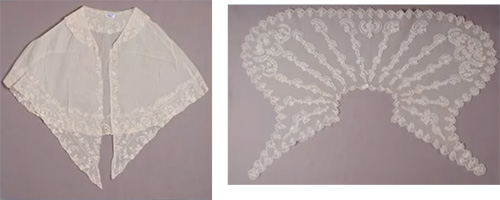
The bodice at the back features princess seams with piping and a center-back closure fastened with hooks and eyes.
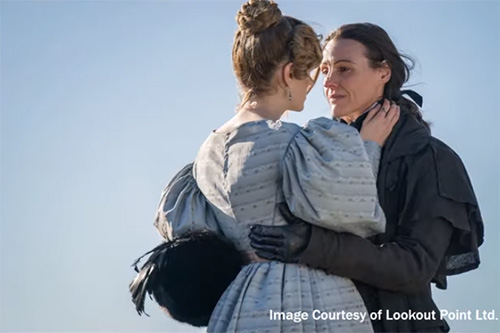
Both the gigot sleeves have full gathers, while the bell-shaped skirt is fully pleated, except at the center front.
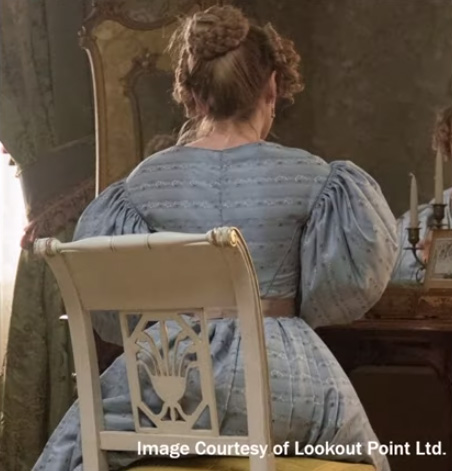
A proper foundation garment was required to support this particular silhouette. Women in the early 1830s would wear underpinning similar to this style of corset, petticoat, and sleeve supporters. And these are all from the FIDM Museum.
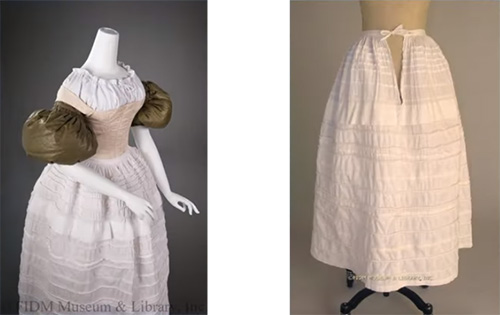
The sleeve supports might be made up of cane or, in this case, cotton stuffed with down.
Ann’s second costume is this silk floral dress.

This design was influenced by fashion plates of the period and this French painting of Madame Jacques-Louis Leblanc from 1823.
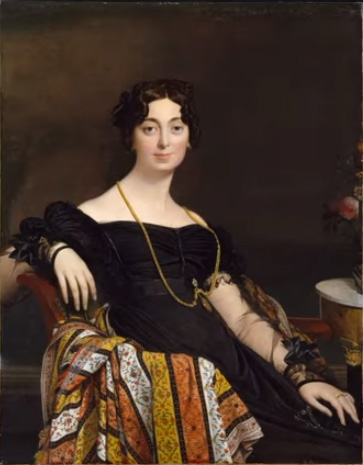
On the right, you can see that the gigot sleeves are smocked and sewn into the drop shoulders with the addition of piping in the seam.

The center front bodice features full gathers under a narrow band. This was a popular style for women in the 1830s.
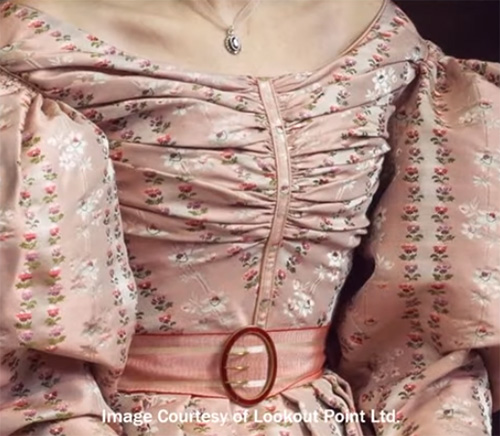
Here are two examples using this same technique as depicted in these two painted portraits. On the left, is an 1830 oil on canvas of Henriette Gleichman von Oven. And on the right, is an 1831 painting of Marchesa Marianna Florenzi.
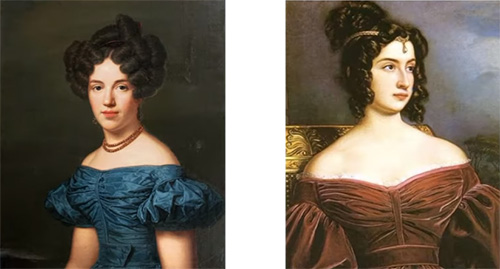
This burgundy silk gown uses a similar technique, except with a pleated chevron pattern instead of gathers. The flat chevron pleats emphasize the desirable V-shape of the 1830s bodices that created the hourglass silhouette. This might also be achieved with soft pleats, gathers, or darts.

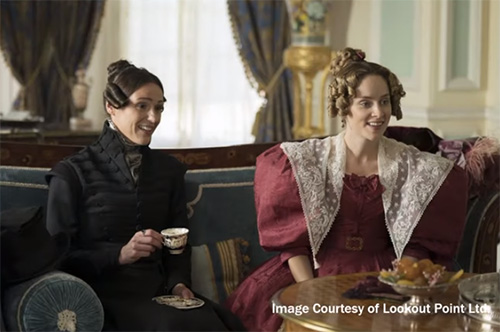
Here's Ann Walker's cotton daydress. The gigot sleeves are cut on the bias and, like Ann's other pink dress, are smocked at the top.

This bodice features a yoke at the front and back, the bodice is gathered at the top and seamed into the yoke.
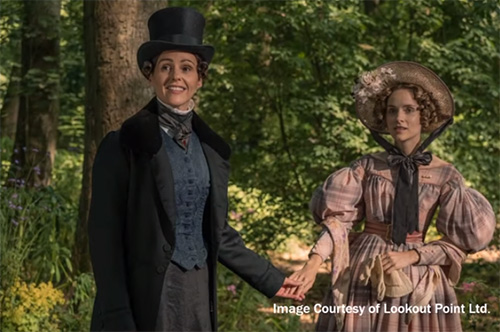
The back seams and yoke feature this contrasting pink piping.
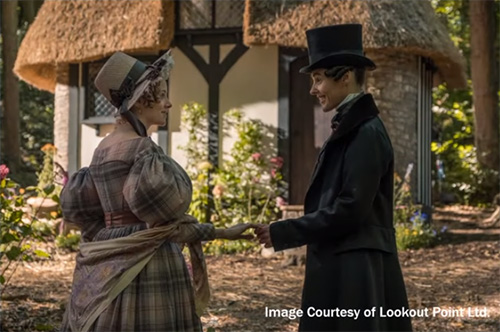
The gathers at the center front waist create the illusion of an even tinier waist.
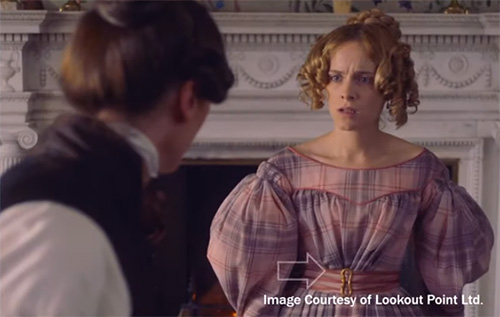
Another popular version of fabric manipulation in this era was full gathers into the neckline and the waistline, with optimum fullness at the center front, as we see in this soft rosy silk gown.

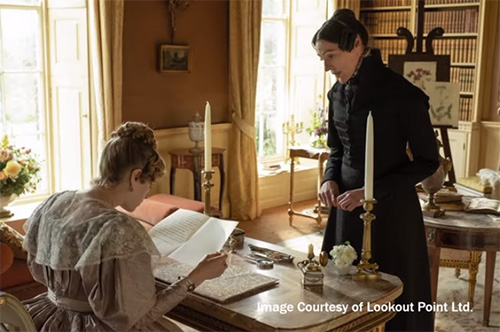
Women's dresses at this time were ankle-length, so you could actually see the shoes.

The Victoria & Albert Museum states that “As skirts increased in width and shortened in length, attention became focused on the foot and ankle. Brightly-colored silk boots or shoes would complement the richness of the gown. Sometimes they were chosen to match the sash or silk ribbons worn with the hat”.
Tom Pye says, “Ann Walker's shoes were always quite impractical. She mainly wore very delicate ballet pumps made from silk or, if she was outside, leather”.
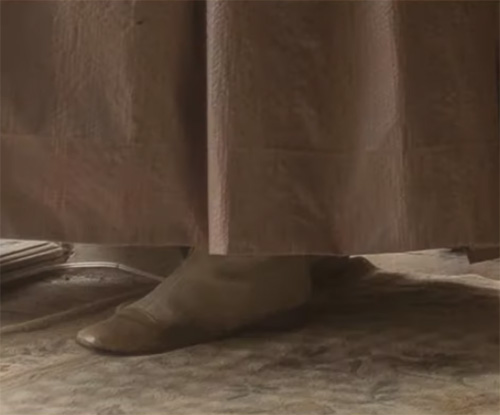
Here are a few examples of flat-heeled boots from The V&A. Both from between the 1830s-1840s. The side-laced boot on the left is made from a corded silk upper, while the boots on the right are made from watered silk uppers. Both have leather soles and are thought to possibly be made in France or Great Britain.
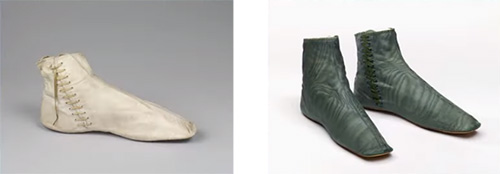
These mint condition canary yellow silk-satin slippers date between 1830-1835.
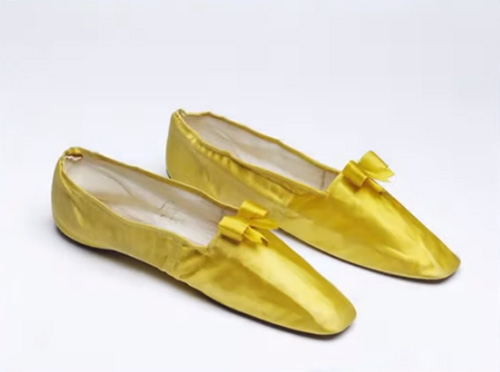
The V&A says, “Due to their fragility, silk slippers were usually reserved for indoor wear, evening dress, or special occasions”.
Looking at these examples, it is not difficult to see why. Although the toes are lined with linen and the back of the upper with kit, they were clearly not made to last.
This otherwise simple pink dress features these short pouf sleeves with a white sheer overlay – a very popular design detail in the 1830s for women's fashion.
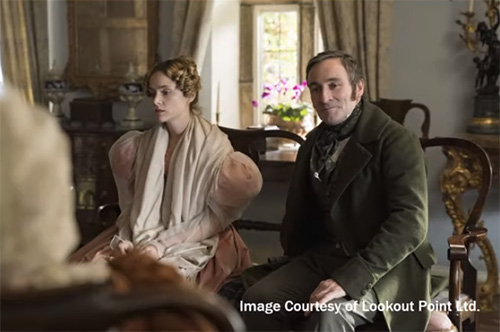
Ann tops the dress with this fringe cream silk piano shawl.

There are painted portraits featuring this style of sleeve, like the countess Julie von Woyna from 1832 by Austrian painter Friedrich von Amerling.
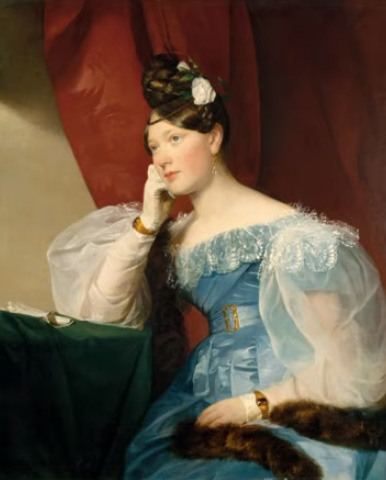
Here is an 1832 cream satin evening gown from Russia with detachable lightweight tulle oversleeves from The Museum at FIT.
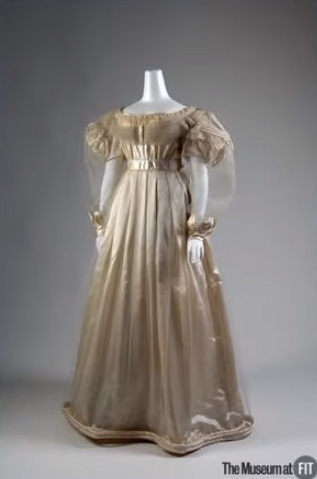
We’ve touched on Ann's underpinnings briefly earlier, but here's a screengrab of her in her chemise, drawers, and corset or stays, which is made from Buttercup printed cotton.
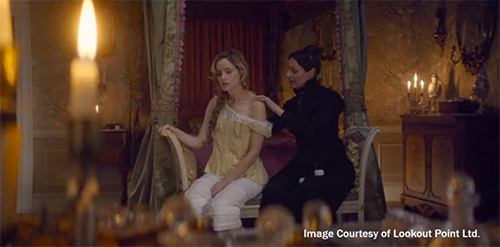
And then, Anne Lister's undergarments, on the other hand, are more utilitarian, as you can see here: Gentleman Jack stage costumes. Extravagant and historically accurate outfits of Anne Lister.
According to The V&A, the shift has been an essential element of underwear for centuries and remain so into the 19th century. When the sheer fabrics and rather clinging styles of neoclassical dress became fashionable in the 1790s, drawers were introduced into female wardrobe for the sake of modesty. They continued to be worn when 19th-century dresses evolved into more substantial styles.
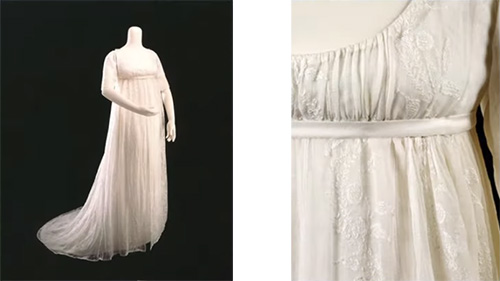
So both of these 1830s garments are hand-sewn. The chemise on the left is linen and it's trimmed in cotton. And then the drawers or pantaloons on the right are made from cotton.
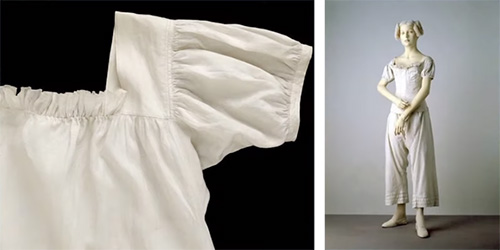
This is an example of an 1830s cotton corset from The FIDM Museum. Cording was favored over boning in the earlier part of the 19th century.
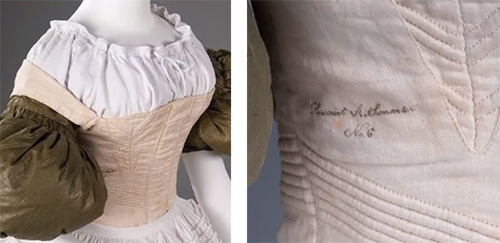
What was particular to this time was the bone or wooden busk that slid into the center front pocket of the corset.
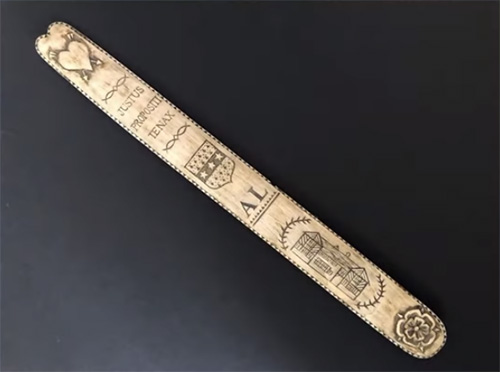
This cotton sateen American corset from about 1830 from The Museum of Fine Arts in Boston is a very similar style to Ann Walker’s. It's rare that the busk, which is pictured on the right, is still with the corset.
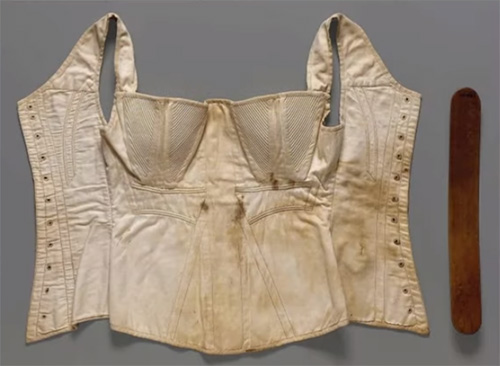
And as a side note, engraved wooden busks were popular gifts from men to their sweethearts, since the busk would have been worn close to the body.
This is another beautiful costume with a more casual, at-home look. She’s wearing this midi blouse with the square knot necktie and full skirt.
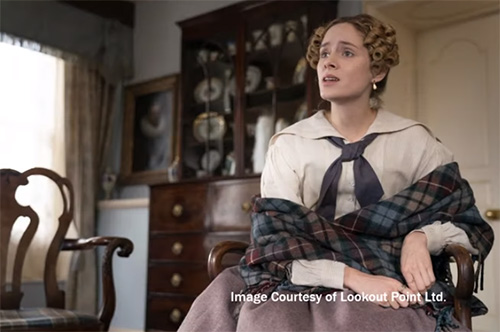
Tom Pye says that he doesn't know if the shawl is a real tartan or not because it's a vintage piece that he picked up from a fair, but he just loved the colors.
And finally, here's Ann’s wedding dress.

According to the Bankfield Museum exhibit, the dress design was based upon a fashion plate in the New York Public Library.
Here are close-ups of silver silk and velvet of this dress.

The coat dress is fastened at the front with silver buttons and topped with a contrasting pelisse collar.
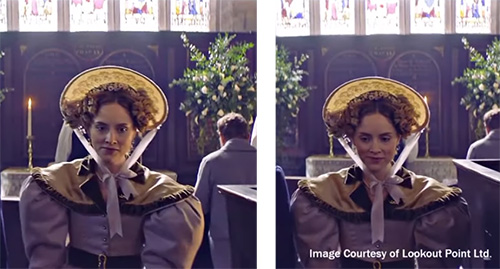
The velvet edging of the pelisse is ruched to give it this additional bit of texture.
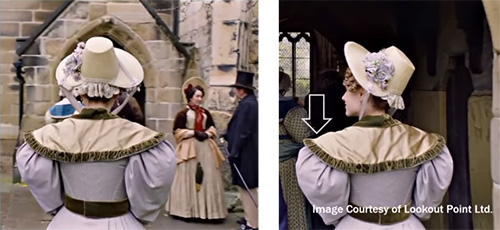
This style of straw bonnet was often referred to as a Leghorn bonnet, because the straw derived from Livorno, Italian for “leghorn”.
Here's an example of a slightly earlier bonnet from the Los Angeles County Museum of Art, thought to be English or Italian. It’s made from Leghorn straw and silk ribbons.

Marian Lister
One of her pretty dresses is a cotton check dress.
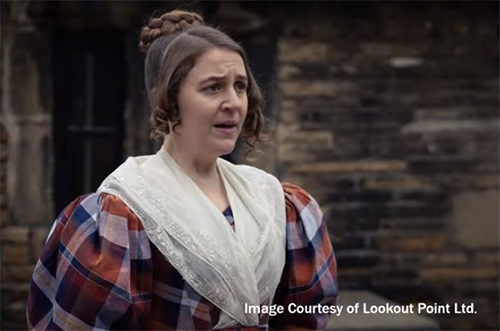
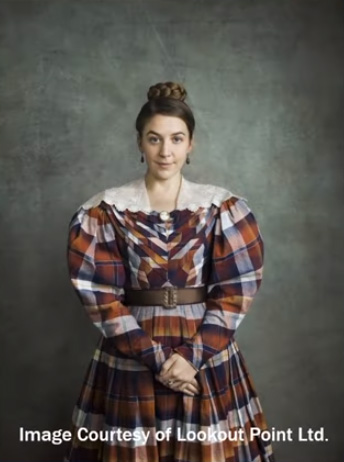
It was inspired by this British silk dress circa 1830 from The Costume Institute at The Met.
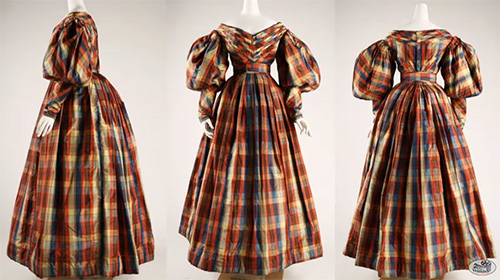
This picture shows the completed dress topped with a pelerine fichu.

Eliza Preistly
This is Eliza Preistly's carriage dress with pelerine.
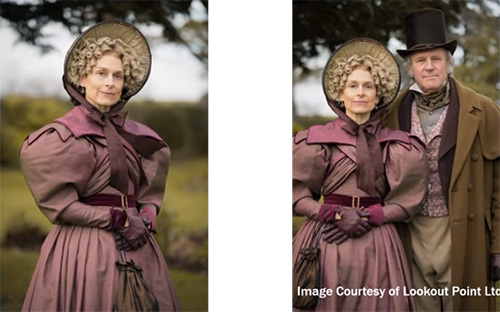
The pelerine is inspired by an 1830s fashion plate from the magazine La Belle Assemblee.

According to the Bankfield exhibit, Eliza's caps are used to create a contrast between high fashion of the day and Anne Lister's extreme and masculine outfits.
Here's another example of a piano shawl.

According to The V&A, the square shawl was a popular shape in Europe, where ladies both wore square shawls and used them in interior decoration. They draped them over pianos and tables and pin them on walls.
This particular velvet cape reminds us of the crenellations of a medieval castle.
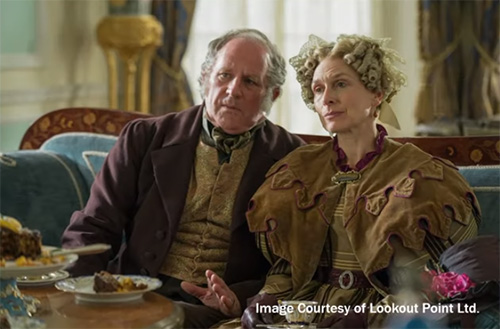
This dark gold dupioni silk gown with a fine cord detail is gorgeous. Such a beautiful contrast to the magenta and teal ribbons of her hat.
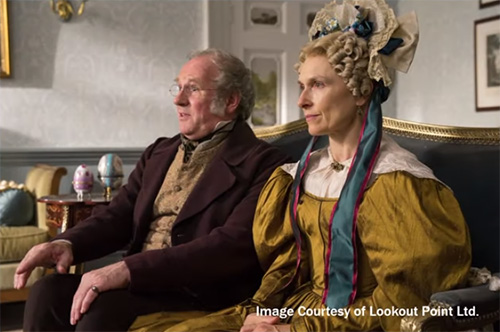
Vere Hobart
Here is Vere Hobart's exquisite wedding gown.
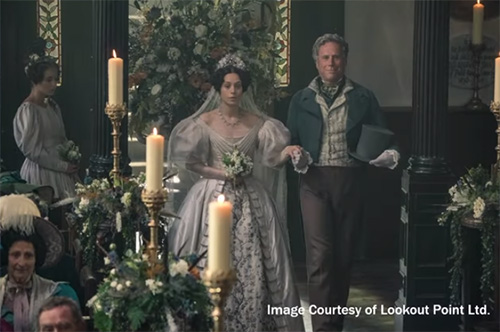
The ribbon folds on the overskirt were inspired by this La Mode 1834 fashion plate.

And the sleeves were based upon the sheer oversleeve that was extremely popular in this time.
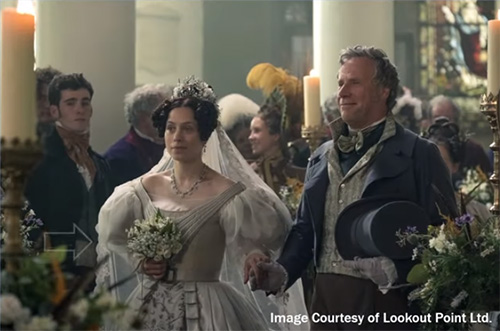
Here’s an example – Waldmüller portrait from the 19th century.
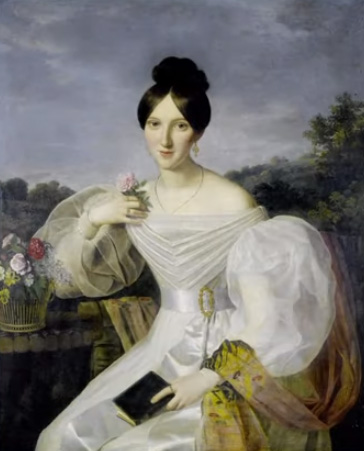
A very sheer modesty piece has been added to the low neckline. This piece of fabric sewn inside of the neckline would often be called a “tucker”.
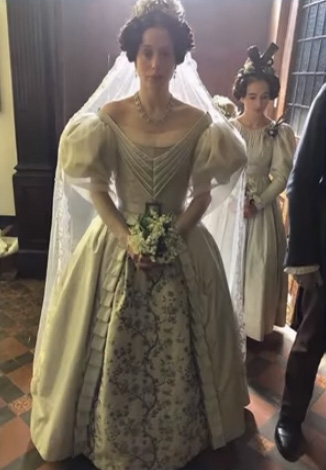
Queen Marie of Denmark
The dress of Queen Marie of Denmark is based upon court dress styles of the time.
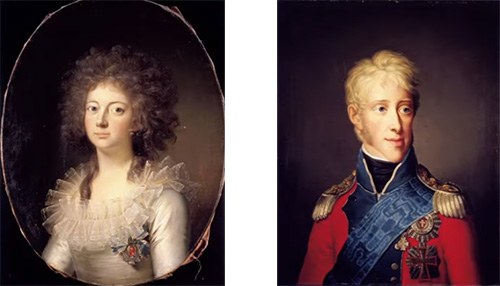
While a romantic silhouette, this gown has a bit of a Renaissance feel with a slash velvet outer sleeve.
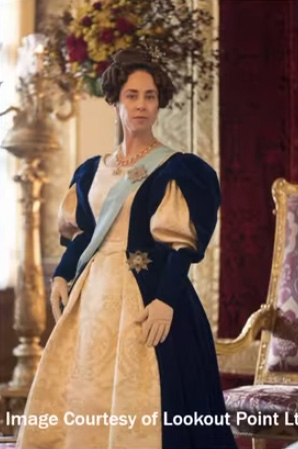
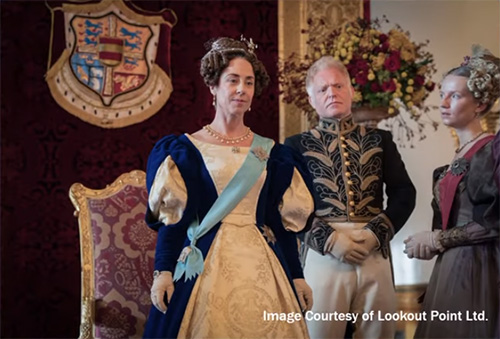
Read also: Stage costumes of Gentleman Jack series, a scandalous 2019 historical drama
Gentleman Jack stage costumes. Extravagant and historically accurate outfits of Anne Lister
(c)


